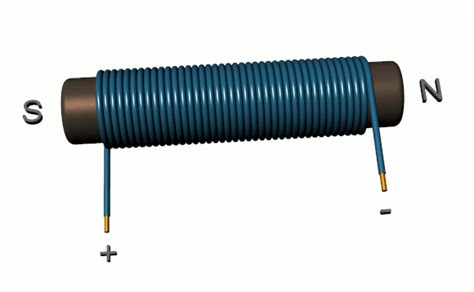Electromagnets are essential components in many electrical and electronic devices. They are widely used in electric motors, generators, transformers, and solenoids. They are also employed in various applications such as MRI machines, magnetic levitation trains, and particle accelerators.

How Electromagnets Work
An electromagnet is essentially a coil of wire wrapped around a ferrous core. When an electric current passes through the coil, it creates a magnetic field. The magnetic field strength is directly proportional to the current flowing through the coil and the number of turns in the coil.
The ferrous core plays a crucial role in enhancing the magnetic field strength. It concentrates the magnetic field lines and increases the overall magnetic flux density. This makes electromagnets much more powerful than permanent magnets.
Types of Electromagnets
Electromagnets can be classified into two main types based on the type of core material used:
1. Iron-Core Electromagnets: These electromagnets use iron as the core material. Iron is a ferromagnetic material, meaning that it can easily be magnetized when exposed to a magnetic field. Iron-core electromagnets are relatively inexpensive and produce strong magnetic fields, making them suitable for various applications.
2. Air-Core Electromagnets: As the name suggests, these electromagnets do not use a ferrous core. Instead, the coil is wound around an air core. Air-core electromagnets have lower inductance and can generate higher frequencies compared to iron-core electromagnets. They are often used in high-frequency applications such as radio antennas and transformers.
Applications of Electromagnets
Electromagnets have a wide range of applications across various industries and fields:
1. Electric Motors and Generators: Electromagnets are used to create the rotating magnetic field in electric motors. They also play a crucial role in generators, where they convert mechanical energy into electrical energy.
2. Transformers: Electromagnets are used in transformers to transfer electrical energy from one circuit to another. They are responsible for changing the voltage and current levels in the circuit.
3. Solenoids: Solenoids are electromechanical devices that use electromagnets to create linear motion. They are commonly used in valves, switches, and actuators.
4. Magnetic Resonance Imaging (MRI) Machines: MRI machines use powerful electromagnets to generate a strong magnetic field. This magnetic field aligns the protons in the body, allowing for detailed imaging of internal structures.
5. Magnetic Levitation Trains: Maglev trains use electromagnets to levitate above the tracks, reducing friction and enabling high-speed travel.
6. Particle Accelerators: Electromagnets are used in particle accelerators to accelerate charged particles to very high speeds. These particles are then used in scientific research and medical applications.
Advantages of Electromagnets
Electromagnets offer several advantages over permanent magnets:
1. Variable Magnetic Field: The magnetic field strength of an electromagnet can be easily controlled by adjusting the current flowing through the coil. This allows for fine-tuning of the magnetic field for specific applications.
2. Reversible Operation: Electromagnets can be turned on and off, which makes them suitable for applications where the magnetic field needs to be switched.
3. Compact Size: Electromagnets can be designed in a compact form factor, making them ideal for use in space-constrained applications.
Disadvantages of Electromagnets
Despite their advantages, electromagnets also have some disadvantages:
1. Power Consumption: Electromagnets require a continuous supply of electrical current to generate a magnetic field. This can lead to power consumption and heat dissipation.
2. Coil Resistance: The coil of an electromagnet has resistance, which can limit the maximum current flow and affect the magnetic field strength.
3. Core Saturation: Iron-core electromagnets can experience core saturation at high current levels, which can lead to a decrease in magnetic field strength.
1. Use a Laminated Core: Laminating the iron core can reduce eddy current losses and improve the efficiency of the electromagnet.
2. Optimize Coil Design: The number of turns, wire size, and coil shape can be optimized to achieve the desired magnetic field strength and power consumption.
3. Use Proper Insulation: The coil of an electromagnet should be properly insulated to prevent electrical shorts and ensure safe operation.
4. Consider Heat Dissipation: Electromagnets can generate heat, so it is important to provide adequate heat dissipation mechanisms to prevent overheating.
1. What is the difference between an electromagnet and a permanent magnet?
An electromagnet requires an electrical current to generate a magnetic field, while a permanent magnet has a fixed magnetic field that does not require any external power.
2. What is the purpose of the iron core in an electromagnet?
The iron core concentrates the magnetic field lines and increases the overall magnetic flux density, making the electromagnet more powerful than a coil without a core.
3. How can I increase the magnetic field strength of an electromagnet?
Increasing the current flowing through the coil or increasing the number of turns in the coil will increase the magnetic field strength.
4. What is the advantage of using an air-core electromagnet?
Air-core electromagnets have lower inductance and can generate higher frequencies compared to iron-core electromagnets, making them suitable for high-frequency applications.
5. What are the applications of electromagnets?
Electromagnets are used in electric motors, generators, transformers, solenoids, MRI machines, maglev trains, and particle accelerators.
6. What are the disadvantages of using electromagnets?
Electromagnets require a continuous supply of electrical current, have coil resistance, and can experience core saturation at high current levels.
Electromagnets are versatile and essential components in various electrical and electronic devices and applications. They provide a controllable and reversible magnetic field, making them ideal for a wide range of industries and scientific research. By understanding the principles of operation, advantages, disadvantages, and practical considerations for using electromagnets, we can harness their power to develop innovative solutions and advance technological progress.
